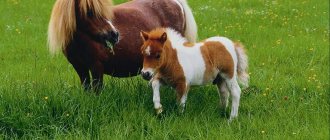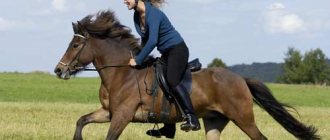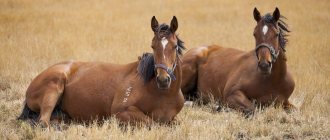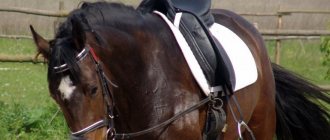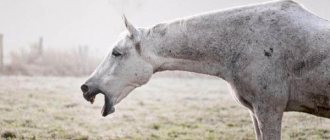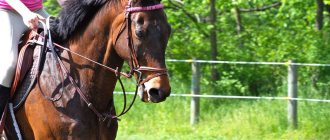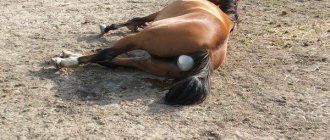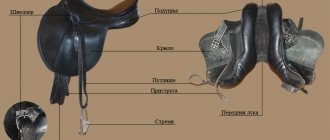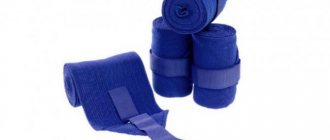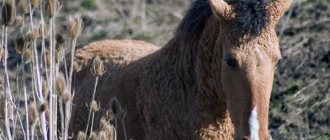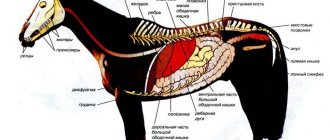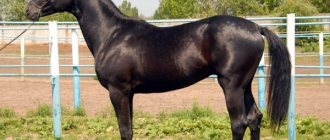The Shire is a breed of draft horse (draught) native to England. Shires confidently hold the palm among the “giants” of the equestrian world and are the tallest horses on the planet. It is a representative of this breed who holds the world record for height among horses. In the 19th century, in the small English town of Bedfordshire, there lived a “baby” 2.2 meters tall and weighing 1.52 tons. His name was very symbolically “Samson”.
Admiring these powerful creatures, you experience a slight dissonance. It’s hard to imagine how such large, strong and muscular giants can combine these qualities with amazing elegance, sweet beauty and a good disposition. When you look at these horses, you take your breath away, and when you sit on them, you feel dizzy. They are majestic, beautiful and very strong.
origin of name
The name of the breed comes from the English word "shire", which translates as county . Thus, in many names of English counties, for example, such as Cambridgeshire, Gloucestershire, Hampshire and others, the word “shire” is used in the second part of the name.
If we examine the etymology of the name of the breed in more detail, it turns out that the “progenitor” of the word “shire” is an ancient Saxon term, which implied a certain border or division.
And today in England there is a slang term for the central part of this state. In particular, the central counties of England are called “shires”.
At the same time, it is believed that the “Horse of the Central Counties” received its current name thanks to King Henry VIII. If you believe history, it was this king, nicknamed “copper nose,” who was the first to call giant horses shires.
Shire today
Today, almost no exhibition or competition is complete without such a unique and capable breed of horse as the Shire. Spectators, as before, admire the aesthetic appearance of the horse, its unique physiology and structure, and are also amazed at the strength and power of its abilities. Shira horses are regularly exported to all parts of the world, participating in the breeding of strong breeds.
For Russia, the Shires made an enormous contribution to horse breeding, becoming the ancestors of many Russian heavy-duty breeds. Most horse lovers and professionals in breeding these animals dream of becoming the happy owners of such a large, powerful and at the same time good-natured and loyal horse like Shire.
In England, the shires annually become the main openers of national show programs and entertainment events, preserving the national spirit and traditions in the country.
History of the breed
The origin of the Shires, as one of the oldest breeds, is lost in the mists of time. Historical evidence (documents and archaeological finds) suggests that back in the 1st century AD . The conquerors of Britain, the Romans, noted the presence of giant and majestic horses on the island. Also, the powerful bodies of horses are depicted on ancient coins and dishes.
There is every reason to believe that the Shires are direct descendants of the so-called medieval “big horse”, which was used mainly for military purposes and came to the British Isles along with the Norman conquerors.
Subsequently, the breed of large horses only gained popularity in England. The “big horse” successfully coped with serious physical exertion. She could easily carry a knight in armor, whose weight sometimes reached 200 kg . Strength and courage, combined with its beauty, led to the horse being used in jousting tournaments.
In England they were very careful when choosing horses for their valiant knights. Thus, a royal decree of 1541 approved a ban on the use of stallions in breeding below a certain height and build. The strictest punishment was established for violation of the decree.
The character and habits of the shires
The impressive size and glorious past of the Shire horse, to the surprise of many people, does not at all indicate its difficult character:
- these are very balanced horses, calm, flexible;
- They are very easy to manage, which is rightfully called one of the main advantages of the species.
The Shire horse is distinguished by extremely well-developed obedience, so breeders certainly use such individuals when they want to breed restive foals.
Of course, such a giant may seem a little clumsy, but this is not true either. Developing the breed, a couple of hundred years ago it was made flexible and agile, with an influx of blood from more agile horses.
We must not forget about their ancestors, who took part in numerous bloody battles over several centuries, because only a brave and determined horse could become a reliable companion for a brave knight
From large to English and black
Subsequently, with the growth of industry and agriculture, the need arose to move large volumes of cargo. It was for such transportation that “big horses” began to be used.
The “big horse” gradually turns from a knightly horse into a draft horse. Chronicles of the 16th century indicate that on the rough roads of England, in the rain and cold, you can often meet horses capable of moving a load weighing more than three tons. Along with the growth of industrial and agricultural production, the number of “big horses” grew.
It was during this period that Friesian, Flemish and German horses were brought to England. And, as it turned out, in the end, not everything German is of high quality and effective.
Thus, the “blood” of German stallions did not have a significant impact on the formation of the Shire breed. But the Frisian and Flemish strongmen contributed to what is now called the “Shire”. The Frisians added a certain lightness and flexibility in movement to the image of the “big horse,” and the Flemings finally shaped the appearance and character.
In the 17th century, thanks to the black coloration of Flemish horses, which was passed on through crossing, the “big ones” began to be called “English crow”. According to sources, the author of this name was the famous English statesman and commander Oliver Cromwell.
But it is still believed that the founder of the entire Shire family and the first of this breed was a stallion named Packington Blind Horse, who lived in the second half of the 18th century. in the small village of Packington, Leicestershire.
It is not known for certain why the stallion received this specific nickname. Was he really blind or did his owners just have such an original imagination?
In the 19th century, Shires became the most sought after and famous heavy draft breed in England. Such popularity could not go unnoticed by foreign professional horse breeders and just amateurs.
At the end of the 19th century, the massive import of horses to the North American continent began, and at the beginning of the 20th century, shires also appeared in Russia.
Attempts at distant exports
In Europe, the breed took root well, which led to its high popularity. But in 1853, several shires were exported to America. Transporting animals was quite expensive and difficult, so the United States was not particularly interested in importing English heavy trucks until 1880. However, the European breed in America was a worthy competitor to the local heavy-duty Percherons. Since about 1910, horses have not only been imported into the country, but also bred locally. During this period, almost 80% of the world's Shire population was raised in the United States.
Shires were brought into Russia only for the purpose of breeding and improving local heavy breeds. For example, the blood of shires is present in Vladimir heavy trucks. Their characteristics were better, but this was not enough for the “English” to oust the domestic “strongmen”.
Studbook
In 1878, the Old English Society of Breeding Horses was formed and the first stud book was created. In the comments to the first edition, Sir Walter Gilbey writes about the courage, strength and beauty of the breed, which conquered the great Roman politician and commander Julius Caesar.
In 1884, the Old English Breeding Horse Society was renamed the Shire Horse Society. Today the stud book consists of three sections. In the first section, absolutely purebred horses are registered. The following sections include horses born as a result of a misalliance.
Tribal registration is carried out very strictly and is controlled at the highest level . To register in any section of the studbook, mandatory confirmation of paternity is required. Previously, blood testing was carried out to determine paternity, but with the development of high technology, DNA testing is now being carried out.
Pros and cons of content
Shires, like other horse breeds, have several advantages and disadvantages that you should familiarize yourself with. Among the advantages are the following:
- high level of carrying capacity, thanks to which it is possible to transport heavy loads;
- hard work and endurance;
- unpretentiousness in nutrition;
- ease of animal care;
- calm temperament and learning ability;
- friendly attitude towards people and animals.
Despite a considerable number of advantages, the Shires have one serious drawback. The main disadvantage of keeping such horses is their large appetite. During the day, an adult eats twice as much food as horses of any other breed.
Exterior
Shires are a large draft horse breed. The body parts are proportionally developed. The back is wide, short and strong. The croup is long and muscular. The head is massive with a wide forehead. The ears are pointed. The tail is set high and bushy. Powerful and muscular legs. The hooves are large and strong. On the lower joints there are fluffy hands - “fries”.
- Height at withers: 165-185 cm.
- Weight: 800 – 1225 kg.
- Color: black, bay, karak, gray, white marks are often found on the legs and head.
Characteristic
The English draft horse is the tallest horse in the world. Representatives of the breed reach almost 2 m at the withers. However, the weight of the animals is not the same. It can be either a fat horse, suitable for leisurely riding, or a large heavy truck, capable of pulling a plow behind it. Shire horses differ from others not only in their height, but also in their appearance.
The English draft horse is the tallest horse in the world
Stallions come in the following colors:
- bay;
- blacks;
- gray.
Slight white spots are allowed. The height of purebred stallions cannot be lower than 173 cm, and the lower limit of permissible weight is 900 kg. Particular attention is paid to the legs. The metacarpus of heavy draft horses is rounded and measures at least 25 cm in girth. This part of the leg is used to judge the overall development of the animal’s locomotor system.
There are also special requirements for the external characteristics of mares, although they are not as strict as for stallions. Mares come in the following colors:
- bay;
- blacks;
- gray;
- roan.
Photo
Care and nutrition
Shires, being horses for agricultural purposes, are very unpretentious in care , and therefore do not require any special care.
However, it is necessary to regularly pay attention to the friezes (hands on the legs). They need to be thoroughly cleaned, washed and dried. Otherwise, the horse may develop midges (a form of dermatitis that affects the horse's legs in the frieze area).
As for nutrition, here too Shires are no different from most horses. High-quality hay, sometimes a small amount of nutritional supplements, and in the summer a mandatory walk on pastures with lush and fresh grass. Naturally, we must not forget that these gentle giants need twice or even three times more food than smaller breeds.
Lifestyle in nature
To get acquainted with such a glorious breed of horses, you need to know exactly what care and living conditions the animals expect from the owner, what food they prefer and in what quantities, as well as what character qualities they possess.
Feeding
For a draft horse, feeding has a number of rules and restrictions: firstly, a draft horse eats about 12-16 kg of hay or fresh vegetation per day, secondly, it rarely needs feeding with concentrates and in small doses, they do not need special feed for growth at all . The best concentrates for such horses are cakes and grass meal, as well as much more. In summer, the daily dose of concentrated feed is from 5 to 7 kg. In addition, the horse will be grateful for vegetables such as beets and carrots.
Care
Shires are often intended for agricultural work, so they are unpretentious in care. It is enough for her to comb the mane and tail, clean the friezes from dirt. Twice a week in the summer, the horse's hair should be washed with shampoo and conditioner, and during the daytime the mane should be braided. Clean drinking is important for the health of the animal.
Content
In order for a horse to feel great and not be exposed to various diseases, it needs the right conditions. Hairy-footed breeds are often susceptible to diseases such as woodlice. To prevent this disease, the horse needs dry bedding in the stable; after work, it must wash and dry its hooves. The most common method of this procedure is to wash the limbs and powder them with sawdust, which are combed out after a couple of hours. Otherwise, shires have no special preferences in maintenance.
Temperament
Sometimes the character of horses is distinguished by the unprecedented calmness of big men and good nature. In any conditions, the horse behaves balanced and wisely, without showing dissatisfaction or emotions. This big, strong horse so skillfully combines power and hard work, kindness and flexibility, due to which it is often used for work in the fields. The whole world truly admires the extraordinary strength and power along with the kindness and obedience of the Shires.
Modern use
Today, Shires are one of the most beloved and sought-after breeds among professional horse breeders and simply horse lovers. These strong and cute horses are very popular with children.
They are rarely used for agricultural needs. Their owners love them very much and therefore take care of them. Shires can also be seen both at specialized exhibitions and shows, where only horses of this breed participate, and at general horse breeding events. Love these wonderful animals and they will love you back .
Character of giants
The huge horse looks intimidating, but despite this, Shire horses are friendly and calm animals. They readily and humbly carry out the assigned work. They have no temper.
Shire horses are friendly and calm
Noble horses are unpretentious, but demanding of nutrition due to their physiology. Such large animals must receive enough protein to remain functional.
